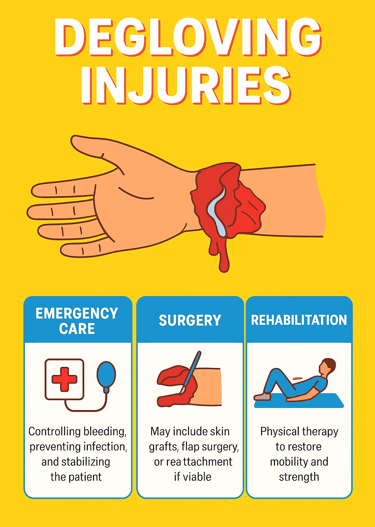Stay updated on what is trending in health. Discover tips and resources for a healthier, balanced life.
Injuries in Humans: Understanding the Different Types and the Shocking Reality of Degloving Injuries
Learn about common injuries including degloving injuries—what causes them, how they’re treated, possible complications, and essential prevention tips. Stay informed to protect yourself and respond quickly in emergencies.
DISEASES AND CONDITIONS
Dr. S. Ali
8/13/20257 min read


Injuries are an unavoidable part of life. From minor scrapes and sprains to severe trauma, our bodies sometimes face damage that needs time — and often medical help — to heal. While many injuries are common and relatively simple to treat, others are rare, shocking, and life-altering. One such example is the degloving injury — a type of trauma that is as serious as it sounds.
Whether you’re reading this out of curiosity, personal experience, or medical interest, this guide will walk you through the different types of injuries humans face, with a special spotlight on degloving injuries, their causes, treatments, and recovery journey.
Common Types of Injuries in Humans
Injuries can be classified in many ways, but most fall under these main categories:
Cuts and Lacerations – Skin and tissue breaks caused by sharp objects, accidents, or falls. These can range from small, superficial nicks to deep wounds that require stitches. Cleaning the area promptly and covering it can help prevent infection and promote healing.
Bruises (Contusions) – Damage to small blood vessels under the skin, usually from blunt trauma. They often appear as blue, purple, or green marks as blood leaks into surrounding tissue.Most heal on their own, but ice packs can reduce swelling and speed up recovery.
Sprains and Strains – Ligament or muscle injuries from overstretching or twisting. Sprains involve ligaments, while strains affect muscles or tendons. Rest, ice, compression, and elevation (the RICE method) are key for early treatment.
Fractures (Broken Bones) – Breaks in the bone due to high-impact trauma or repetitive stress. Symptoms include pain, swelling, and inability to move the affected area normally. Medical attention is crucial to realign and stabilize the bone for proper healing.
Burns – Damage to skin and tissues from heat, chemicals, electricity, or radiation. They are classified into degrees, from minor redness to deep tissue destruction. Immediate cooling (not ice) and covering with a clean cloth can help before medical care.
Crush Injuries – Severe compression of body parts, often affecting muscles, bones, and nerves. These can occur in accidents involving heavy machinery, collapsing structures, or vehicle crashes. They require urgent care to prevent permanent damage and complications like compartment syndrome.
Degloving Injuries – Rare but severe injuries where skin and soft tissue are torn away from underlying structures. They can be caused by machinery accidents, high-speed crashes, or severe falls. Treatment often involves surgery, skin grafts, and long-term rehabilitation.
What is a Degloving Injury?
A degloving injury happens when the skin and underlying tissue are forcefully separated from muscles, bones, or connective tissue beneath. Imagine peeling a glove off a hand — only here, it’s the skin that gets pulled away.
These injuries are medical emergencies that often require immediate surgery, as they can lead to severe bleeding, infection, and even loss of the affected limb if untreated.
Types of Degloving Injuries
There are two main types:
Open Degloving – The skin is completely torn away, exposing underlying tissue such as muscles, tendons, or bone. This type often occurs in high-impact accidents like machinery entrapment or road traffic collisions. Open degloving carries a high risk of infection and usually requires urgent surgical intervention, including skin grafts or reconstructive surgery.
Closed Degloving (Morel-Lavallée Lesion) – The skin remains intact, but tissues underneath are separated, creating a pocket filled with blood, lymph, or fatty fluid. It’s commonly caused by blunt trauma, such as falls or crush injuries. These injuries may not be immediately visible but can lead to swelling, pain, and tissue necrosis if not diagnosed and treated promptly.
Common Causes of Degloving Injuries
Degloving injuries usually occur due to high-energy trauma such as:
Road traffic accidents (especially motorcyclists and cyclists) – Sliding along asphalt or being trapped under a vehicle can easily strip skin and tissue away. Motorcyclists without proper gear are at particularly high risk.
Industrial or workplace accidents involving heavy machinery – Rotating parts, conveyor belts, or rollers can trap clothing and pull skin off in seconds. Lack of safety guards often plays a role.
Farm equipment accidents – Tractors, augers, and harvesters have powerful moving parts that can catch limbs and cause catastrophic injuries.
Animal bites (rare but possible) – Large animals like dogs, horses, or even wild predators can rip away tissue in severe attacks.
Severe sports injuries – High-speed collisions or entanglements, especially in extreme sports, can result in tissue being forcefully separated.
Falls from heights – When a limb is caught or scraped during a fall, the skin can be torn from the force and friction.
Signs and Symptoms
If you or someone near you suffers a traumatic injury, signs of a possible degloving include:
Visible separation of skin and tissue – The most obvious and alarming sign, where underlying muscle, tendons, or bone may be exposed.
Severe bleeding – Blood loss can be rapid and life-threatening, especially if large blood vessels are damaged.
Loss of sensation in the affected area – This could indicate nerve damage, which may affect long-term function.
Skin discoloration (pale, bluish, or black) – A sign of compromised blood flow or tissue death that needs urgent care.
Swelling and fluid build-up – Can result from trapped blood or lymph fluid in closed degloving injuries, and may increase pain and pressure in the area.
How Are Degloving Injuries Treated?
Treatment depends on the extent of damage, but it often involves:
Emergency care – Controlling bleeding, preventing infection, and stabilizing the patient. This initial step is crucial to preserve life and limb, often involving intravenous fluids, pain management, and tetanus prevention. Rapid assessment helps determine the best course for surgical intervention.
Surgery – May include skin grafts, flap surgery, or reattachment if viable. Surgeons carefully evaluate tissue viability to decide the best reconstructive method. Complex cases might require multiple surgeries to restore appearance and function.
Debridement – Removing dead or contaminated tissue. This helps reduce infection risk and promotes healthy wound healing. It may be repeated several times depending on the wound condition.
Vacuum-Assisted Closure (VAC) Therapy – Helps wounds heal faster by promoting tissue growth. The therapy uses controlled negative pressure to improve blood flow and remove excess fluid from the wound. This creates an optimal environment for tissue regeneration and reduces healing time.
Rehabilitation – Physical therapy to restore mobility and strength. Customized rehab programs help patients regain function, reduce stiffness, and manage pain. Psychological support may also be part of recovery to address emotional trauma.
Complications of Degloving Injuries
Even with the best medical care, complications may include:
Infection – Open wounds are highly prone to bacterial contamination. Infections can delay healing and may require antibiotics or further surgical cleaning. Severe infections can lead to systemic illness or sepsis if untreated.
Tissue death (necrosis) – Damaged skin may not survive even after reattachment. Necrosis may necessitate additional surgeries to remove dead tissue and prevent infection. This can result in longer recovery times and more complex reconstruction.
Scarring – Often significant and may require reconstructive surgery. Scars can limit movement or cause cosmetic concerns that impact quality of life. Techniques like skin grafting or laser therapy might be used to improve scar appearance.
Loss of function – Depending on injury severity and location. Nerve or muscle damage can impair sensation, strength, or coordination, affecting daily activities. Rehabilitation aims to maximize recovery but some deficits may be permanent.
Psychological impact – Trauma and visible changes can cause anxiety, depression, or post traumatic stress disorder (PTSD). Emotional support and counseling are important parts of holistic care. Addressing mental health helps improve overall healing and quality of life.
Recovery and Life After a Degloving Injury
Recovery is often long and challenging, involving multiple surgeries, months of physical therapy, and emotional adjustment. Many survivors benefit from counseling to cope with the psychological impact.
In some cases, assistive devices or prosthetics are needed to regain independence.
Preventing Degloving and Other Severe Injuries
While accidents can’t always be avoided, you can lower the risks by taking these precautions:
Follow workplace safety protocols
Always adhere to safety guidelines set by your employer, especially in high-risk environments like construction sites or factories. Proper training, regular equipment checks, and awareness of hazards help prevent accidents before they happen.Wear appropriate protective gear for sports and manual labor
Using gloves, helmets, long sleeves, and sturdy footwear can significantly reduce the chance of injury. Protective gear acts as a barrier against cuts, abrasions, and crushing injuries that may lead to degloving.Use caution around machinery and vehicles
Stay alert when operating or working near heavy machinery, tools, or moving vehicles. Make sure to follow operating instructions, keep clear of moving parts, and never bypass safety features designed to protect you.Educate children on safety rules
Teaching kids about dangers like traffic, sharp objects, and machinery prepares them to recognize and avoid risky situations. Supervising children during play and instructing them on safe behavior reduces the chance of serious accidents.Avoid risky behaviors like speeding or unsafe riding
Driving or riding vehicles responsibly, including obeying speed limits and wearing seat belts or helmets, dramatically lowers injury risk. Reckless actions increase the likelihood of high-impact accidents, which can cause severe trauma like degloving injuries.
The Bottom Line
Injuries to the human body can vary widely—from minor cuts and bruises to severe, life-altering trauma such as degloving injuries. Although degloving injuries are relatively rare, their impact is profound, often involving extensive tissue damage that requires urgent and specialized medical attention. Prompt emergency care can make the difference between saving a limb or facing permanent disability. Beyond the immediate treatment, long-term rehabilitation is crucial to help patients regain function, mobility, and quality of life.
Being proactive about safety—whether at work, during recreational activities, or on the road—plays a vital role in reducing the risk of such serious injuries. Staying informed about how these injuries happen and how to prevent them empowers individuals to take appropriate precautions every day. And if an accident does occur, quick action and proper medical intervention are key to improving outcomes.
Ultimately, understanding both the risks and the necessary responses helps protect not only our bodies but also our futures. Taking safety seriously isn’t just about avoiding harm—it’s about preserving the ability to live fully and independently.
1. Mayo Clinic – Wound Care and Treatment
https://www.mayoclinic.org/tests-procedures/wound-care/about/pac-20384614
2. Medscape – Degloving Injuries: Clinical Features and Management
https://emedicine.medscape.com/article/1260299-overview
3. National Institutes of Health (NIH) – Wound Healing and Reconstruction
https://www.ncbi.nlm.nih.gov/books/NBK537120/
4. American Academy of Orthopaedic Surgeons – Traumatic Injuries and Care
https://orthoinfo.aaos.org/en/diseases--conditions/traumatic-injuries
5. Centers for Disease Control and Prevention (CDC) – Injury Prevention & Control
https://www.cdc.gov/injury/index.html
6. Johns Hopkins Medicine – Plastic and Reconstructive Surgery
https://www.hopkinsmedicine.org/health/treatment-tests-and-therapies/plastic-surgery
Pulse Your Health
Empowering you to achieve your health goals.
Contact
© 2025. All rights reserved.
Disclaimer: The content on this website is for informational purposes only and is not medical advice. Always seek the advice of your physician or other suitably qualified healthcare professional for diagnosis, treatment and your health related needs.
